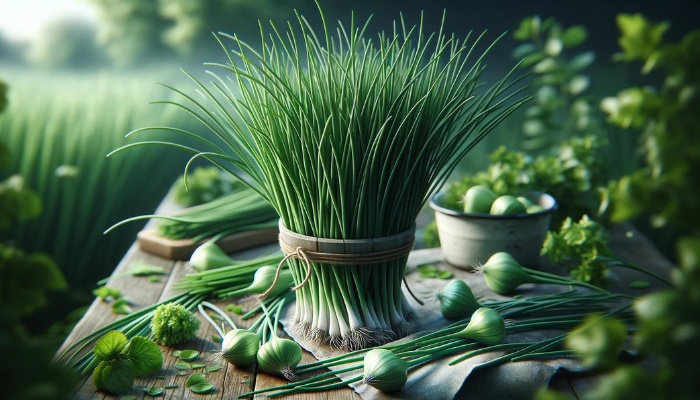To cultivate chives in your square foot garden, start by planning carefully, focusing on sunlight exposure and soil quality. Test and adjust the soil pH to between 6.0-7.0, and enhance it with compost for optimal water retention and drainage.
When planting, space seeds or transplants 4-6 inches apart in a 4×4 grid pattern for efficient use of space, and pair them with carrots or tomatoes to deter pests.
Care for your chives by ensuring the soil stays moist but not soggy, and monitor the pH to maintain nutrient uptake. Begin harvesting when leaves reach 6 inches, cutting 1-2 inches above the soil with sharp scissors for the best flavor.
Integrating these techniques will not only boost your chive production but also equip you with skills for a more sustainable garden.
Planning Your Space
Before planting anything in your square foot garden, it’s important to meticulously plan your space, considering factors such as sunlight exposure, soil quality, and available area.
Soil preparation is your first step toward ensuring a successful chive garden. Chives thrive in well-draining soil with a pH between 6.0 and 7.0.
You’ll need to test your soil’s pH and adjust accordingly. Incorporating organic matter like compost improves soil structure, enhancing water retention and drainage—key aspects of chive cultivation.
Your watering schedule is equally vital. Chives require consistent moisture, especially during the growing season, but they despise waterlogged roots.
Implementing a drip irrigation system within your square foot garden can provide even, efficient watering that meets chives’ needs without overdoing it.
Plan to water your chives deeply once a week, adjusting based on rainfall and temperature. Always check the soil moisture by feeling it; if the top inch feels dry, it’s time to water.
Planting Your Chives
Before planting, soil preparation is key. Chives thrive in well-draining soil rich in organic matter.
Ideally, you’ve already integrated compost or well-rotted manure into your garden patch, which will provide the necessary nutrients for your chives to flourish.
Plant chive seeds or transplants at a depth of ¼ inch, spacing them 4 to 6 inches apart to allow for ample air circulation and growth.
If you’re using square foot gardening methods, consider dedicating 1 square foot per 16 chive plants, utilizing a 4×4 grid pattern to maximize space efficiently.
Chive companions can significantly enhance your garden’s productivity. Planting chives near carrots and tomatoes can deter pests and encourage healthy growth among these companions.
Their natural insect-repellent properties make chives invaluable allies in the garden.
Caring for Chives
Once your chives are planted, consistent watering and monitoring for pests is critical for their growth.
Chives, like many herbaceous plants, prefer soil that remains moist but not waterlogged. Overwatering can lead to root rot, a common issue that stifles the health of your plants.
To prevent this, ensure your soil preparation includes adding organic matter that enhances drainage while retaining necessary moisture.
Chive varieties often have slightly different care requirements. For instance, common chives (Allium schoenoprasum) are quite hardy and adapt well to a range of conditions, whereas garlic chives (Allium tuberosum) may demand more sunlight to develop their characteristic flavor.
Regardless of the variety, ensuring your soil is well-prepared before planting is key. A pH between 6.0 and 7.0 is ideal for chives because it allows optimal nutrient uptake.
Regular checks for pests such as aphids and spider mites are also essential. These pests can quickly colonize the foliage, sucking sap and reducing the plant’s vigor.
Implementing an integrated pest management (IPM) approach, which might include introducing beneficial insects or applying organic pesticides, can help keep your chive crops healthy and productive.
Harvesting Techniques
Ideally, you’ll start harvesting when the leaves are at least 6 inches tall, which typically takes about 60 days from planting. This allows the plants to have enough foliage to recover quickly.
For optimal flavor, harvest in the morning after the dew has evaporated but before the sun is too intense.
To harvest, use clean, sharp scissors, and cut the leaves about 1-2 inches above the soil surface. This method encourages new growth, ensuring a continuous supply.
Be judicious in your harvesting, taking no more than one-third of the plant at a time.
For storage methods, freshly harvested chives can be kept in the refrigerator for up to a week. Wrap them loosely in a damp paper towel and place them in a plastic bag.
For longer preservation, chives can be chopped and frozen in an airtight container or dried and stored in a cool, dark place. Both methods retain much of the herb’s flavor, making your effort well worth it.
Pest and Disease Management
To ensure your chives thrive, it’s essential to implement effective pest and disease management strategies tailored to common threats.
Utilizing natural repellents is a foundational step in protecting your chives without introducing harsh chemicals into your square foot garden.
For instance, planting companion plants that emit strong scents, such as marigolds or garlic, near your chives can deter aphids and other pests naturally.
These companions act as a first line of defense, warding off potential invaders through their aromatic properties.
In addition to natural repellents, integrating biological controls into your pest management strategy enhances your garden’s resilience against pests and diseases.
Introducing beneficial insects, like ladybugs or lacewings, can drastically reduce the population of aphids and mites that may target your chives.
These predators feed on harmful pests, maintaining a balanced ecosystem within your square foot garden without resorting to synthetic pesticides.
Furthermore, regular monitoring and proper sanitation practices play a crucial role in disease prevention.
Removing affected plant parts promptly and avoiding overhead watering can minimize the risk of fungal infections, ensuring your chives remain healthy and vigorous throughout the growing season.
By combining these scientific and practical approaches, you’ll create a robust defense system for your chives against common pests and diseases.

